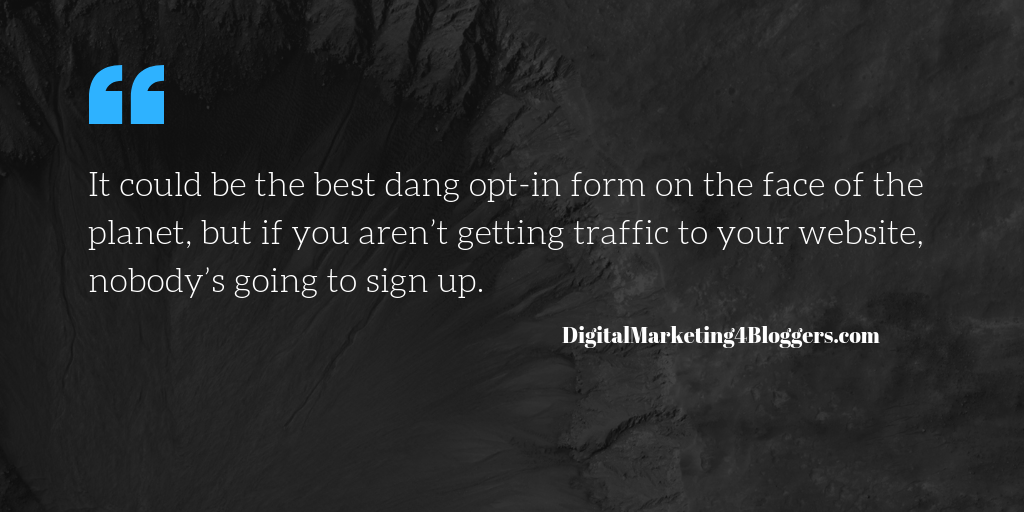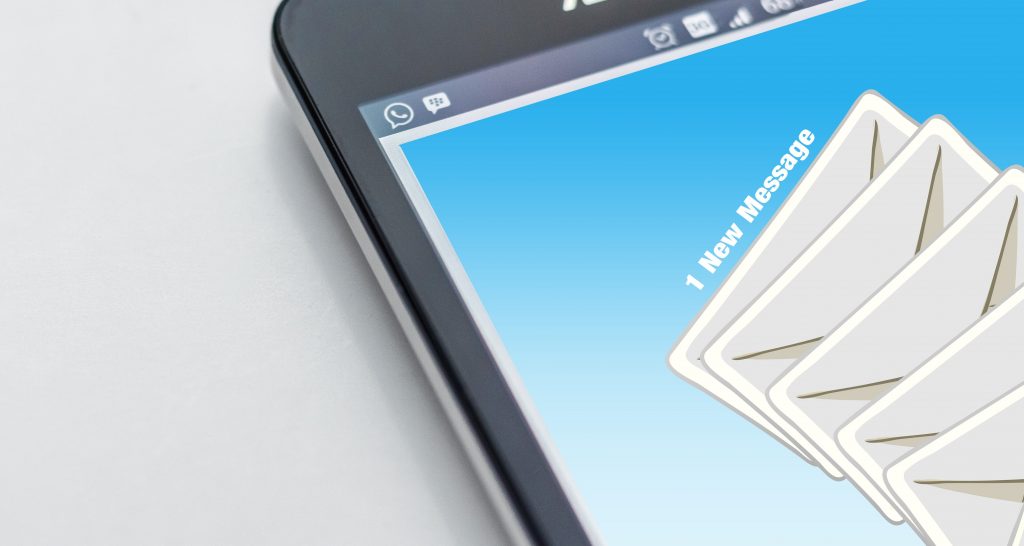Do you want to know a little secret that will make or break your email opt-in forms? Creating an opt-in form that generates a slew of new email addresses isn’t about the words that you use. Or the colors you select. Or the giveaway you’re offering.
No. Don’t get me wrong – all those things are important. In fact, very important.
But, here’s the thing. Before creating an opt-in form that piles email address into your email marketing service, you need something fundamental, first.
Web traffic.
I don’t care how “well-crafted” your form is. Or whether you paid $10,000 for a seasoned content writer to come up with the perfect set of words that just reach straight out and grab the attention of your reader.
It could be the best dang opt-in form on the face of the planet, but if you aren’t getting traffic to your website, nobody’s going to sign up.
You need traffic first.
What’s the point of putting this at the very top of this article? There are a bunch of clever tactics to help increase your conversion rate on your opt-in forms. People do some crazy-effective stuff that works. It works like crazy.
But, a lot of tutorials out there about digital marketing don’t address the most obvious part of all this: forms need eyeballs. You need to put butts in the seats before you even have a chance at piling emails into your email system.
So, understand that before we move on. Understand that you need web traffic.

10 tactics to create crazy-effective opt-in forms
Okay, here we go. These top 10 tactics work for so many bloggers. They generate interest and almost require your reader to fork over their email address. They are crazy-effective and build lists that amass 10s or 100s of thousands of emails.
Also, please note: Top-converting email forms do not only capture email subscribers. The best forms also keep them around through value and interest. These tips cover both areas of email forms – the capture, but also keeping those precious emails.
Are you ready?
1. Include an opt in form on every page
Without fail, include an
For example, I have an opt-in form on the homepage. It’s also in my sidebar on the right as well as below each and every article. Make it insanely easy to opt-in.
2. Offer something of value (content upgrades)
This one seems obvious, but it’s also an often-forgotten step. Newer bloggers tend to simply ask for email addresses to keep the reader updated on new content.
Okaaaaaaaay.
You might love your content and every last word that you write, but that doesn’t necessarily mean your readers place equal value. If you aren’t offering something tangible, you’re leading potential email subscribers away from your opt-in.
Offer content or additional value in exchange for their email.
For example:
- A free 5-day email course (I do this!)
- A digital PDF download (like an infographic)
- Freebies (links to free stuff, ideas for free things, etc)
- Checklists, simple guides or cheat sheets
- Access to a live webinar with you
I think you get the idea. Readers are much more likely to fork over their email address if they are getting something tangible in return.
How is this done? Most email marketing services offer autoresponders that can automatically email new subscribers something immediately after signing up. These emails can include an attachment or a link to download their content upgrade.
If you’re using ConvertKit, you can also create an email sequence to design a series of emails to keep the subscriber engaged with their upgrade.
For the record, I love using email sequences.
3. Advertise your content upgrade on your opt-in
Once again, this might seem obvious. But, it’s not. If you create some sort of content upgrade, then advertise that upgrade on your opt-in forms.
Mention that by signing up for your email list or newsletter, they will get a content upgrade that directly helps them in some way.
Check out my email opt-in below.
Notice that I’m advertising the content upgrade, not the inclusion to my email list. The headline is about getting a million blog pageviews. If you’re on this site, that’s super important to you. The techniques I learned over the years of blogging are the value that I’m offering in this upgrade, and I’ve put them into a 5-day email sequence using ConvertKit. It’s quick, effective and converts like crazy.
4. Make sure it’s something that your reader actually wants
There’s only a single rule to creating an effective content upgrade: it needs to be something that your reader actually wants.
Weird, huh?
What does your reader want? Well, answer this simple question: why is your reader there on your site and spending their previous time reading your content? What value are they getting out of their time on your site?
Are you offering news or analysis? Are you selling something? Teaching?
Whatever it is, make it applicable. Your reader is there for a reason. If you’re blogging about hamster wheels, then your content upgrade should relate to hamster wheels.
Using my opt-in form as an example, you’re here to learn more about digital marketing for bloggers and increasing pageviews and/or sales. My opt-in directly relates by offering details about how I got my first 1,000,000 pageviews.
5. Be honest
There is nothing that will turn off potential audiences quicker than a dishonest opt-in form. If you promise something, deliver it. And likewise, if you promise not to spam them with useless stuff that they didn’t sign up for, then don’t do that.
If they signed up for wisdom about raising a pet goat, don’t flood their email with unrelated nonsense about the stupid things your cat did the other day.
If you said that you’re giving them a super detailed PDF that describes a step-by-step process for negotiating a better rate on their car insurance, make sure that PDF is as you describe. It’s detailed. It’s step-by-step. It’s been reviewed by someone other than yourself to ensure it makes sense, contains no errors and is genuinely helpful.
Unsubscribing is easy. Honestly ensures you’re keeping the emails you’re collecting.
6. Include value in email that’s not on your blog
Resist the temptation to simply email out a direct RSS copy of new blog posts to your email list. Frankly, that doesn’t provide a lot of value. It does notify your list of a new blog post, and that’s great. It might help with your pageviews.
But, give your email subscribers more value by giving them something that they wouldn’t find word-for-word on your site.
For example:
- Write a custom introduction to your newest blog post with a little background about why you wrote it and what they will learn; then, provide a link to it.
- Send a monthly “Best Reads” round-up email that links your readers directly to content that you enjoyed over that month (to include content on other blogs).
- Increase engagement by asking questions in your emails. The answers you get might become perfect topics for future blog posts (or it might just satisfy your own curiosity). You might be surprised at how many subscribers will respond.
- Sell. If you’re offering a product, timely emails with discounts or testimonials can increase awareness and keep your readers thinking about spending money on whatever it is that you’re offering. Don’t sell all the time.
7. Write emails that are easy to read
Be honest: whenever you open a new email (especially if it’s from a company or website), you don’t immediately start reading, do you?
No, probably not right away. I don’t either. Something happens before I start.
Subconsciously, I mentally scan the visible parts of the email. My brain is assessing the work it’s going to take to digest that email. In other words, I’m asking myself “Is this email worth my time?”
Believe it or not, how your email content looks is equally important to what you’re writing. Good content makes readers want to read. This is critical to building and maintaining a solid email open rate.
Writing well-designed email content looks remarkably similar to writing effective content for your blog. You know, things like:
- Using simple, everyday English
- Writing smaller paragraphs that are easy to digest
- Bolding and italicizing text for emphasis
- Making text scannable with bulleted lists and headings
Don’t give me a giant wall of text because I won’t read it. Ever. And, your email subscribers won’t read it, either.
8. Giveaways and free stuff
People love getting free stuff, and a lot of people are willing to fork over their email if it means that they have a chance of winning something.
I’ve run giveaways for gift cards and books and they worked remarkably well. They got people interested. But, giving away gift cards isn’t the most effective giveaway in most cases. Why? Because they are generic things. They don’t relate specifically to your audience and why your readers are there.
For example, giving away a subscription to Ahrefs.com would make an excellent giveaway for a website about blogging. Or, a collection of five personal finance books might encourage participation on a finance site.
The key is to require them to sign up for your email list to enter the giveaway.
9. Use link triggers to track subscriber interest
If you’re using an email provider like ConvertKit, you’ll have access to a capability called “Link Triggers”. Link triggers are a way to trigger an action immediately after a user clicks on a link in your email.
In ConvertKit, link triggers are created from the Automations page. Click Automations, then select the ‘Rules’ link at the top right, as shown below.

Then, add a new rule.
Within the Trigger area on the left, choose ‘Clicks a link’. Then, you’ll see the following screen to create your new link trigger.

Name your trigger (though names are optional, I highly recommend giving it a name) and specify a destination URL (where the user will be brought after clicking).
On the right hand side of the screen under ‘Action’, select what you want to happen whenever a user clicks on that link.

This is incredibly powerful. With just a click of a link, ConvertKit allows bloggers to assign subscribers to tags, forms and sequences quickly and easily.
To actually use the link trigger, simply select it when you’re placing a link in your email (ConvertKit calls these emails “broadcasts”). Notice the ‘Link Triggers’ drop down box on the right of the URL:

Here’s where giving your link trigger a name makes it easy to select from this
You might not realize it, but companies use link triggers all the time.
Why use link triggers?
- Makes it easy to include “Click here if you’d like to be notified…” in your email. Assign a tag to each user that clicks the link, then email all users subscribed to that tag when it makes sense.
- If a user clicks on a link to one of your products but doesn’t buy, consider sending out an email with a discount code to help encourage a purchase.
- After writing a bunch of email courses, send out an email with links to each course; use link triggers to automatically subscribe each user to the course(s) that they select from the links in your email.
The options with link triggers are nearly limitless, and tracking user interest is one of the best ways to keep the subscribers that you have and improve engagement. You’re empowering your email subscribers with choices, and people love feeling in control.
10. Check out what other bloggers are doing
My last tip isn’t about your opt-in form or email marketing strategy per say, but it does relate to the overall “ideation” process of coming up with your next idea: pay attention to what the influencers are doing.
Sign up for other email lists and check out what the successful people do. I’m talking about folks like Neil Patel and Ramit Sethi. Learn from those who kill it with their email marketing strategy. They are proven. And, most of them have tried every trick in the book. They know what works and put the best techniques to good use.
Oh, but here’s the thing: If you like someone’s email strategy, don’t just steal it. It’s okay to copy, but be sure that you’re installing your own bit of flair into your emails.
Remember that audiences between blogs are vastly different. What works for them won’t necessarily work for you because their audience might be different from yours.
My larger point is to expose yourself to as many ideas, techniques and tactics that you can. Use those that make the most sense and use things like UTM codes to judge their effectiveness. Keep what works and ditch was doesn’t.
Because experimentation is half the fun, right?
Before we leave, here’s an awesome infographic from EmailMonks with 10 different types of email forms and how they work. Which ones of these have you tried?






